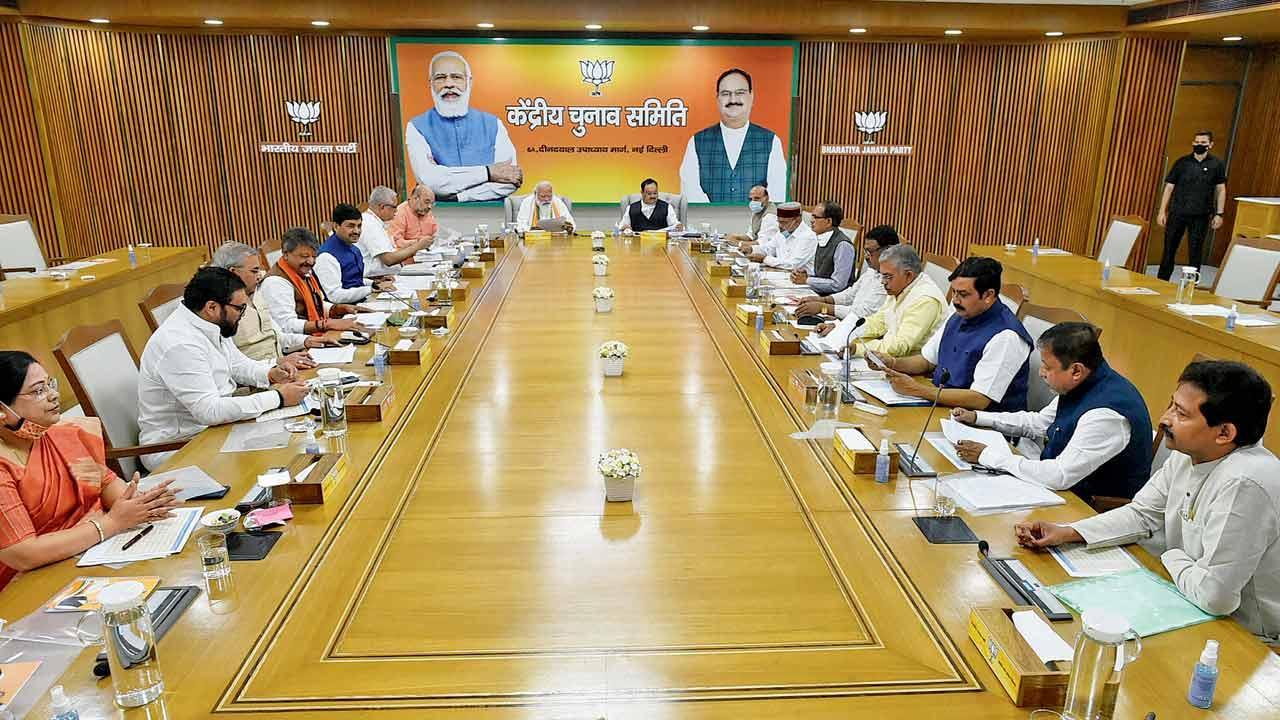The social class of bhadralok, which is dominated by the upper castes — has ruled the nursery of Hindutva through one party or another. Upcoming polls will show if a politics bereft of the struggle of lower castes and communities can endure against the BJP

PM Narendra Modi chairs BJP’s Central Election Committee (CEC) meeting to select candidates for West Bengal Assembly polls in New Delhi on Saturday. PIC/PTI
The Bharatiya Janata Party gazes upon West Bengal with the conqueror’s eye, for it knows that the party ruling in Kolkata often wins a large chunk of the 42 seats the state has in the Lok Sabha. A BJP victory in the West Bengal Assembly elections would enable the party to offset losses suffered elsewhere in the future war to control the Centre. The victory would likely decimate the communists, who are the BJP’s most steadfast ideological foe, and trumpet the limitation of regional identity rooted in language to counter the political-religious ideology of Hindutva, which seeks to culturally unite diverse Hindu social groups, often with conflicting interests, across India. This has always been an upper-caste project.
ADVERTISEMENT
For the Rashtriya Swayamsevak Sangh, West Bengal is the Promised Land, so to speak. It was here RSS founder KB Hedgewar studied medicine, and was influenced by the political Hinduism of Bankim Chandra Chatterjee and Aurobindo Ghose. This is the land of Swami Vivekananda, whom the RSS re-imagined as the proponent of virile Hinduism. It is to this state Guru Golwalkar came to become a monk, but then abandoned his ascetic ambition to become the second chief of the RSS. West Bengal was the home of Shyama Prasad Mukherjee, the founder-president of the Bharatiya Jana Sangh (BJS), the BJP’s earlier avatar.
Academician Pralay Kanungo aptly says, in his paper, The Rise of Bharatiya Janata Party in West Bengal, “Nineteenth-century Bengal produced the seed of Hindu nationalism, which germinated in Maharashtra giving birth to the RSS in 1925.” In fact, that seed showed signs of sprouting even in West Bengal, in the 1951-52 general elections. The BJS then performed far better here than at the all-India level, where it bagged 3 per cent votes in Lok Sabha and 2.76 per cent in state legislative elections, in comparison to the party winning two Lok Sabha seats in West Bengal with a 5.59 per cent vote-share, and securing nine seats in the State Assembly on a vote-share of 5.58 per cent.
But the green shoots died with the demise of Mukherjee in 1953. A member of the Hindu Mahasabha from 1939 to 1948, Mukherjee’s politics represented the anxiety of bhadralok or gentlefolk, a social class dominated by the upper castes, who knew they could not wield power in undivided Bengal, which had a Muslim majority and Hindu lower castes in substantial numbers. The Hindu Mahasabha resorted to communal mobilisation to co-opt the lower castes and ensure the bhadralok retained control over power. Its limited success had the Mahasabha, like the Muslim League, to vociferously advocate the partition of Bengal. The division of Bengal in 1947 reduced the population of Muslims and the Scheduled Castes in West Bengal. The ebbing away of the bhadralok’s anxiety eroded its need for the Hindu Right, which, anyway, had been discredited for its role in the assassination of Gandhi. The death of Mukherjee led to the BJS’s vote-share slumping below 1 per cent in West Bengal in all but one general election until 1972.
The bhadralok ruled the State through the Congress. At the same time, the bhadralok-dominated Left spearheaded the Opposition, which batted for the refugees, largely lower castes, and stressed upon social justice by invoking class rather than the language of caste. In power, the Left undertook land reforms. Yet the Ram Janmabhoomi movement indicated that religious identity is not as malleable to class politics as is presumed, for the BJP bagged 11.66 per cent of votes in the 1991 Assembly elections, although that dipped to 6.45 per cent five years later.
The BJP received a fillip because of its alliance with the Trinamool Congress, which Mamata Banerjee established after leaving the Congress in 1997. The BJP’s vote-share again crossed 10 per cent in the 1989 and 1999 Lok Sabha elections. Under the protective shield of the Vajpayee government at the Centre, the BJP made inroads into West Bengal through a combination of divisive programmes and work among the adivasis. Although Mamata broke away from the BJP in 2001, the latter was by now expanding beyond its small but loyal base of Hindu nationalists drawn, as Kanungo notes, from the upper castes, Marwari businesspersons, Hindi-speaking migrants, and refugees.
Eighteen years later, in the 2019 Lok Sabha elections, the BJP polled 40 per cent of votes. The survey of Lokniti-CSDS (Centre for the Study of Developing Societies) shows that 66 per cent of the Hindu electorate voted for the BJP. Trinamool won 22 seats, four more than the BJP, only because of the solid support of Muslims. The 2019 results testified to the lotus blooming in what once was the nursery of Hindu nationalism – and later became the crucible of class politics.
In his essay Battle for the Bhadralok, Ishan Mukherjee writes, “The Left-wing bhadralok delegitimised the language of caste itself. Jyoti Basu plainly told the Mandal Commission that in Bengal there were only two castes: the rich and the poor.” Basu’s certitude has been matched by Mamata, who has pitted the Bengali cultural identity against Hindutva to checkmate the BJP. West Bengal’s Assembly results will show whether politics around class and language-region can endure in the absence of marginalised castes and communities asserting themselves through their autonomous movements for rights.
The writer is a senior journalist. Send your feedback to mailbag@mid-day.com. The views expressed in this column are the individual’s and don’t represent those of the paper.
 Subscribe today by clicking the link and stay updated with the latest news!" Click here!
Subscribe today by clicking the link and stay updated with the latest news!" Click here!






